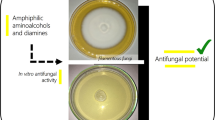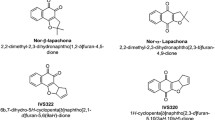Abstract
The aim of this study was to investigate the in vitro activity of thirty-eight heterocyclic organoboron compounds (1a–o, 2a–j, 3a–m) against clinically isolated dermatophytes Trichophyton mentagrophytes and Microsporum canis. Minimum inhibitory concentrations (MICs) of compounds (1a–o, 2a–j, 3a–m) were determined according to published protocol Clinical and Laboratory Standards Institute (CLSI) M38–A2 broth microdilution method. The minimum fungicidal concentrations (MFCs) for both T. mentagrophytes and M. canis were found by subculturing each fungal suspension on potato dextrose agar. According to the results, heterocyclic organoboron compounds (1a–o, 2a–j, 3a–m) were found to be more effective against dermatophyte M. canis (MIC = 3.12–25 µg/ml) than T. mentagrophytes (MIC = 12.5–100 µg/ml). Our findings showed that 7–membered heterocyclic organoboron compounds (3a–m) (MIC = 12.5–50 µg/ml) have stronger in vitro antifungal activity against T. mentagrophytes than 5–membered heterocyclic organoboron compounds (1a–o, 2a–j) (MIC = 25–100 µg/ml). The MFC values for all compounds ranged from 6.25 to 200 µg/ml. The limited number of systemic antifungal agents used in the treatment of dermatophyte infections and the presence of side effects have led to the search for new treatment resources in recent years. Therefore, investigation of the effect of heterocyclic organoboron compounds against dermatophytes will be promising for the discovery of new antifungal compounds that have gained great importance today.


Similar content being viewed by others
References
Hanedan B, Bilgili A, Uysal MH (2021) Health risks that fungal infections of skin in cats and dogs cause in humans, control and treatment choices. Icontech International Journal 5(2):10–17. https://doi.org/10.46291/ICONTECHvol5iss2pp10-17
Gräser Y, Monod M, Bouchara JP, Dukik K, Nenoff P, Kargl A, Kupsch C, Zhan P, Packeu A, Chaturvedi V, Hoog S (2018) New insights in dermatophyte research. Med Mycol 56(1):2–9. https://doi.org/10.1093/mmy/myx141
Mignon B, Monod M (2011) Zoonotic infections with dermatophyte fungi. Clinical Practice and Public Health Control, Oxford Textbook of Zoonoses-Biology
Baumgardner DJ (2017) Fungal infections from human and animal contact. J Patient Cent Res Rev 4(2):78–89. https://doi.org/10.17294/2330-0698.1418
Iorio R, Cafarchia C, Capelli G, Fasciocco D, Otranto D, Giangaspero A (2007) Dermatophytoses in cats and humans in central Italy: epidemiological aspects. Mycoses 50(6):491–495. https://doi.org/10.1111/j.1439-0507.2007.01385.x
Gezer AH, Acar A (2020) Effects of boron compounds and ozonated olive oil on experimental Microsporum canis infection in rats. Turk J Vet Anim Sci 44:258–265. https://doi.org/10.3906/vet-1910-51
Ferguson L, Fuller LC (2017) Spectrum and burden of dermatophytes in children. J Infect 74(1):54–60. https://doi.org/10.1016/S0163-4453(17)30192-5
Martinez-Rossi NM, Peres NTA, Rossi A (2008) Antifungal resistance mechanisms in dermatophytes. Mycopathologia 166:369–383. https://doi.org/10.1007/s11046-008-9110-7
Hayette MP, Sacheli R (2015) Dermatophytosis, trends in epidemiology and diagnostic approach. Curr Fung Infect Rep 9(3):164–179. https://doi.org/10.1007/s12281-015-0231-4
Chermette R, Ferreiro L, Guillot J (2008) Dermatophytoses in animals. Mycopathologia 166:385–405. https://doi.org/10.1007/s11046-008-9102-7
Moriello KA (2004) Treatment of dermatophytosis in dogs and cats: review of published studies. Vet Dermatol 15(2):99–107. https://doi.org/10.1111/j.1365-3164.2004.00361.x
Gupta AK, Foley KA, Versteeg SG (2017) New antifungal agents and new formulations against dermatophytes. Mycopathologia 182(1–2):127–141. https://doi.org/10.1007/s11046-016-0045-0
Elewski BE (1998) Onychomycosis: pathogenesis, diagnosis, and management. Clin Microbiol Rev 11(3):415–429. https://doi.org/10.1128/CMR.11.3.415
Bao Y, Wan Z, Li R (2013) In vitro antifungal activity of Micafungin and Caspofungin against dermatophytes isolated from China. Mycopathologia 175:141–145. https://doi.org/10.1007/s11046-012-9571-6
Yamaguchi MU, Silva APB, Ueda-Nakamura T, Filho BPD, Silva CC, Nakamura CV (2009) Effects of a thiosemicarbazide camphene derivative on Trichophyton mentagrophytes. Molecules 14(5):1796–1807. https://doi.org/10.3390/molecules14051796
Dogra S, Shaw D, Rudramurthy SM (2019) Antifungal drug susceptibility testing of dermatophytes: laboratory findings to clinical implications. Indian Dermatol Online J 10(3):225–233. https://doi.org/10.4103/idoj.IDOJ_146_19
Noguchi H, Matsumoto T, Hiruma M, Kimura U, Kano R, Yaguchi T, Fukushima S, Ihn H (2019) Tineaunguium caused by terbinafine-resistant Trichophyton rubrum successfully treated with fosravuconazole. J Dermatol 46(12):e446–e447. https://doi.org/10.1111/1346-8138.15033
Negri M, Salci TP, Shinobu-Mesquita CS, Capoci IR, Svidzinski TI, Kioshima ES (2014) Early state research on antifungal natural products. Molecules 19:2925–2956. https://doi.org/10.3390/molecules19032925
Adamatzky A, Nikolaidou A, Gandia A, Chiolerio A, Dehshibi MM (2021) Reactive fungal wearable. BioSystems 199:104304. https://doi.org/10.1016/j.biosystems.2020.104304
Wang L, Lou Z, Jiang K, Shen G (2019) Bio-multifunctional smart wearable sensors for medical devices. Advanced Intelligent Systems 1(5):1900040. https://doi.org/10.1002/aisy.201900040
Mondal S, Zehra N, Choudhury A, Iyer PK (2021) Wearable sensing devices for point of care diagnostics. ACS Appl Bio Mater 4(1):47–70. https://doi.org/10.1021/acsabm.0c00798
Mohankumar P, Ajayan J, Mohanraj T, Yasodharan R (2021) Recent developments in biosensors for healthcare and biomedical applications: a review. Measurement 167:108293. https://doi.org/10.1016/j.measurement.2020.108293
Ouf SA, Moussa TA, Abd-Elmegeed AM, Eltahlawy SR (2016) Antifungal potential of ozone against some dermatophytes. Braz J Microbiol 47(3):697–702. https://doi.org/10.1016/j.bjm.2016.04.014
Abdel-Shafi S, Al-Mohammadi A, Almanaa TN, Moustafa AH, Saad TMM, Ghonemey A, Anacarso I, Enan G, El-Gazzar N (2020) Identification and testing of antidermatophytic oxaborole-6-benzene sulphonamide derivative (OXBS) from Streptomyces atrovirens KM192347 isolated from soil. Antibiotics 9(4):176. https://doi.org/10.3390/antibiotics9040176
Asgarpanah J, Hashemi SJ, Hashemi E, Askari K (2017) In vitro antifungal activity of some traditional Persian medicinal plants on pathogenic fungi. Chin J Integr Med 23(6):433–437. https://doi.org/10.1007/s11655-015-2181-7
Ye L, Lin P, Du W, Wang Y, Tang C, Shen Z (2018) Preparation, antidermatophyte activity and mechanism of methylphloroglucinol derivatives. Front Microbiol 9:2262. https://doi.org/10.3389/fmicb.2018.02262
Mousavi SAA, Kazemi A (2015) In vitro and in vivo antidermatophytic activities of some Iranian medicinal plants. Med Mycol 53(8):852–859. https://doi.org/10.1093/mmy/myv032
Bajpai VK, Yoon JI, Kang SC (2009) Antioxidant and antidermatophytic activities of essential oil and extracts of Metasequoia glyptostroboides Miki ex Hu. Food Chem Tox 47(6):1355–1361. https://doi.org/10.1016/j.fct.2009.03.011
Rezgui M, Majdoub N, Mabrouk B, Baldisserotto A, Bino A, Ben Kaab LB, Manfredini S (2020) Antioxidant and antifungal activities of marrubiin, extracts and essential oil from Marrubium vulgare L. against pathogenic dermatophyte strains. J Mycologie Medicale 30(1):100927. https://doi.org/10.1016/j.mycmed.2020.100927
Khayyat S, Al-Kattan M, Basudan N (2018) Phytochemical screening and antidermatophytic activity of lavender essential oil from Saudi Arabia. Int J Pharmacol 14(6):802–810. https://doi.org/10.3923/ijp.2018.802.810
Trifan A, Bostănaru AC, Luca SV, Grădinaru AC, Jităreanu A, Aprotosoaie AC, Miron A, Cioancă O, Hăncianu M, Ochiuz L, Bujor A, Aelenei P, Mareș M (2020) Antifungal potential of Pimpinella anisum, Carum carvi and Coriandrum sativum extracts. A comparative study with focus on the phenolic composition. Farmacia 68(1):22–27. https://doi.org/10.31925/farmacia.2020.1.4
Choi KD, Kim HY, Shin IS (2017) Antifungal activity of isothiocyanates extracted from horseradish (Armoracia rusticana) root against pathogenic dermal fungi. Food Sci Biotechnol 26(3):847–852. https://doi.org/10.1007/s10068-017-0104-4
Sharma M, Tiwari M (2012) A study of dermatophytes in dogs and in vitro response of Psoralea corylifolia essential oil. Jeobp 15(3):445–453. https://doi.org/10.1080/0972060X.2012.10644071
Bajpai VK, Yoon JI, Kang SC (2009) Antifungal potential of essential oil and various organic extracts of Nandina domestica Thunb. against skin infectious fungal pathogens. Appl Microbiol Biotechnol 83:1127–1133. https://doi.org/10.1007/s00253-009-2017-5
Soković M, Ristić M, Grubišić D (2004) Chemical composition and antifungal activity of the essential oil from Juniperus excelsa berries. Pharm Biol 42(4–5):328–331. https://doi.org/10.1080/13880200490511936
Patra M, Shahi SK, Midgely G, Dikshit A (2002) Utilization of essential oil as natural antifungal against nail-infective fungi. Flavour Fragr J 17(2):91–94. https://doi.org/10.1002/ffj.1049
Noorkorina TKT, Ab Aziz FM, Alojid AAM, Ahmad NN, Salmuna ZN, Asma Hassan S, Hashim S, Harun A (2021) Antifungal effects and phytochemical screening of Andrographis paniculate extracts on dermatomycoses. Malays J Microbiol 17(5):576–587. https://doi.org/10.21161/mjm.211144
Tiwari N, Pandit R, Gaikwad S, Gade A, Rai M (2017) Biosynthesis of zinc oxide nanoparticles by petals extract of Rosa indica L., its formulation as nail paint and evaluation of antifungal activity against fungi causing onychomycosis. IET Nanobiotechnol 11(2):205–211. https://doi.org/10.1049/iet-nbt.2016.0003
Najar B, Mecacci G, Nardi V, Cervelli C, Nardoni S, Mancianti F, Ebani VV, Giannecchini S, Pistelli L (2021) Volatiles and antifungal-antibacterial-antiviral activity of South African Salvia spp. essential oils cultivated in uniform conditions. Molecules 26(9):2826. https://doi.org/10.3390/molecules26092826
Foss SR, Nakamura CV, Ueda-Nakamura T, Cortez DAG, Endo EH, Filho BPD (2014) Antifungal activity of pomegranate peel extract and isolated compound punicalagin against dermatophytes. Ann Clin Microbiol Antimicrob 13:32. https://doi.org/10.1186/s12941-014-0032-6
Mousavi SAA, Salari S, Hadizadeh S (2015) Evaluation of antifungal effect of silver nanoparticles against Microsporum canis, Trichophyton mentagrophytes and Microsporum gypseum. Iran J Biotech 13(4):e1302. https://doi.org/10.15171/ijb.1302
Kazemi M, Akbari A, Zarrinfar H, Soleimanpour S, Sabouri Z, Khatami M, Darroudi M (2020) Evaluation of antifungal and photocatalytic activities of gelatin-stabilized selenium oxide nanoparticles. J Inorg Organomet Polym 30:3036–3044. https://doi.org/10.1007/s10904-020-01462-4
Furmanek L, Czarnota P, Seaward MRD (2019) Antifungal activity of lichen compounds against dermatophytes: a review. J Appl Microbiol 127(2):308–325. https://doi.org/10.1111/jam.14209
Brasch J, Flader S (1996) Human androgenic steroids affect growth of dermatophytes in vitro. Mycoses 39:387–392
Pir M, Agirbas H, Budak F, Sahin O (2017) Synthesis, characterization, antimicrobial activity and QSAR studies of some new 6-substituted phenyl 3-(4-chlorophenyl)-3a,4,8,8a-tetrahydro-[1,3,2]dioxaborepino[5,6-d]isoxazoles. Heteroatom Chem 28(2):e21363. https://doi.org/10.1002/hc.21363
Pir M, Agirbas H, Budak F, Ilter M (2016) Synthesis, characterization, antimicrobial activity, and QSAR studies on substituted oxadiazaboroles. Med Chem Res 25(9):1794–1812. https://doi.org/10.1007/s00044-016-1603-1
Pir M (2021) Synthesis of some dioxaborepine derivatives and determination of antimicrobial activity. DEUFMD 23(68):501–507. https://doi.org/10.21205/deufmd.2021236813
Clinical and Laboratory Standards Institute (CLSI) (2008) Reference method for broth dilution antifungal susceptibility testing of filamentous fungi: approved standard. 2nd ed. M38-A2. Vol 28, No. 16, Wayne, PA, USA.
Fernandez-Torres B, Cabanes FJ, Carillo-Munoz AJ, Esteban A, Inza I, Abarca L, Guarro J (2002) Collaborative evaluation of optimal antifungal susceptibility testing conditions for dermatophytes. J Clin Microbiol 40(11):3999–4003. https://doi.org/10.1128/JCM.40.11.3999-4003.2002
Clinical and Laboratory Standarts Institute (CLSI) (2002) Reference method for broth dilution antifungal susceptibility testing of yeast: approved standard. 2nd ed. M27-A2. Wayne, PA, USA.
Benderdour M, Bui-van T, Dicko A, Belleville F (1998) In vivo and in vitro effects of boron and boronated compounds. J Trace Elements Med Biol 12:2–7
Song S, Gao P, Sun L, Kang D, Kongsted J, Poongavanam V, Zhan P, Liu X (2021) Recent developments in the medicinal chemistry of single boron atom-containing compounds. Acta Pharmaceutica Sinica B 11(10):3035–3059. https://doi.org/10.1016/j.apsb.2021.01.010
Neves WW, Neves RP, Macedo DPC, Eleamen GRA, Kretzschmar EAM, Oliveira EE, Mendonça-Junior FJB, Lima-Neto RG (2020) Incorporation of 2-amino-thiophene derivative in nanoparticles: enhancement of antifungal activity. Braz J Microbiol 51:647–655. https://doi.org/10.1007/s42770-020-00248-7
Machado GRM, Diedrich D, Ruaro TC, Zimmer AR, Teixeira ML, Oliveira LF, Jean M, Weghe PV, Andrade SF, Gnoatto SCB, Fuentefria AM (2020) Quinolines derivatives as promising new antifungal candidates for the treatment of candidiasis and dermatophytosis. Braz J Microbiol 51:1691–1701. https://doi.org/10.1007/s42770-020-00348-4
Silva LC, Miranda MACM, Freitas JV, Ferreira SFA, Lima ECO, Oliveira CMA, Kato L, Soares CMA, Pereira M (2020) Antifungal activity of Copaíba resin oil in solution and nanoemulsion against Paracoccidioides spp. Braz J Microbiol 51:125–134. https://doi.org/10.1007/s42770-019-00201-3
Araujo DE, Oliveira AA, Cabral MS, CostanAF SBC, Silva LC, Menezes LB, Soares CMA, Amaral AC, Pereira M (2020) Investigation of thiosemicarbazide free or within chitosan nanoparticles in a murine model of vulvovaginal candidiasis. Braz J Microbiol 51:1465–1473. https://doi.org/10.1007/s42770-020-00326-w
Pereira FO (2021) A review of recent research on antifungal agents against dermatophyte biofilms. Med Mycol 59:313–326. https://doi.org/10.1093/mmy/myaa114
Junior FAS, Brilhante RSN, Cordeiro RA, Brito EHS, Sidrim JJC, Rocha MFG (2007) Glucose improves the in vitro viability of Microsporum canis and Trichophyton mentagrophytes var. Mentagrophytes J Microbiol Methods 69:218–221. https://doi.org/10.1016/j.mimet.2006.12.014
Funding
This work was supported by Kocaeli University Scientific Research Projects Coordination Unit. Project Number: FHD–2021–2437.
Author information
Authors and Affiliations
Corresponding author
Ethics declarations
Conflict of interest
The authors declare no competing interests.
Additional information
Responsible Editor: Rosana Puccia
Publisher's note
Springer Nature remains neutral with regard to jurisdictional claims in published maps and institutional affiliations.
Rights and permissions
About this article
Cite this article
Pir, M., Budak, F. & Metiner, K. In vitro antifungal activity of heterocyclic organoboron compounds against Trichophyton mentagrophytes and Microsporum canis obtained from clinical isolates. Braz J Microbiol 53, 1297–1303 (2022). https://doi.org/10.1007/s42770-022-00777-3
Received:
Accepted:
Published:
Issue Date:
DOI: https://doi.org/10.1007/s42770-022-00777-3




